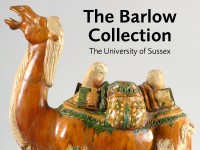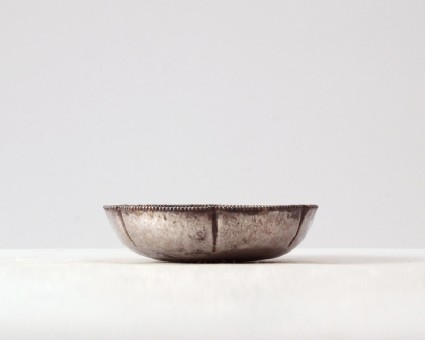The Barlow Collection
A select catalogue of the Barlow collection of Chinese Ceramics, Bronzes and Jades by the University of Sussex (published Sussex, 2006).

Publications online: 456 objects
Bowl with a dancing apsara, or celestial maiden
- loan
-
Literature notes
The inscription records this bowl as item no.14 of tribute offerings for the Princely Residence of [the late] Prince Wenzhong in the year dingmao of the Taiping period. A large number of gold and silver vessels dedicated to Prince Wenzhong (AD 941–1011) are recorded, including several bowls of similar form.
The shallow rounded bowl has no foot and the sides are indented into six lobes. The rim is surrounded by pearl beading and the centre inside is decorated with a dancing apsara (winged celestial maiden in Buddhism), depicted in a lively pose, her legs crossed and one slightly raised, one arm raised, holding long ribbons, wearing a tall tiara-like headdress and a bejewelled necklace, and loosely draped trousers. The figure is surrounded by quatrefoil florets on a ring-punched ground, enclosed by a link-chain border, and the designs are picked out in gilding. The design is faintly visible on the underside, where it is surrounded by a 17-character inscription. -
Details
- Associated place
-
Asia › China › Liaoning province (place of creation)
- Date
-
AD 1027
Liao Dynasty (AD 907 - 1125)
- Material and technique
- silver, with ring-punched and gilded decoration
- Dimensions
-
3 cm (height)
10.7 cm (diameter)
- Material index
- Technique index
-
covered › metallized › gilded
- Object type index
- No. of items
- 1
- Credit line
- Lent by the Sir Alan Barlow Collection Trust.
- Accession no.
- LI1301.34
-
Further reading
University of Sussex, and Arts and Humanities Research Council, The Barlow Collection, supervised by Regina Krahl, Maurice Howard, and Aiden Leeves (Sussex: University of Sussex, 2006), no. P1
Location
-
- currently in research collection
Objects are sometimes moved to a different location. Our object location data is usually updated on a monthly basis. Contact the Jameel Study Centre if you are planning to visit the museum to see a particular object on display, or would like to arrange an appointment to see an object in our reserve collections.
Publications online
-

The Barlow Collection
The inscription records this bowl as item no.14 of tribute offerings for the Princely Residence of [the late] Prince Wenzhong in the year dingmao of the Taiping period. A large number of gold and silver vessels dedicated to Prince Wenzhong (AD 941–1011) are recorded, including several bowls of similar form.
The shallow rounded bowl has no foot and the sides are indented into six lobes. The rim is surrounded by pearl beading and the centre inside is decorated with a dancing apsara (winged celestial maiden in Buddhism), depicted in a lively pose, her legs crossed and one slightly raised, one arm raised, holding long ribbons, wearing a tall tiara-like headdress and a bejewelled necklace, and loosely draped trousers. The figure is surrounded by quatrefoil florets on a ring-punched ground, enclosed by a link-chain border, and the designs are picked out in gilding. The design is faintly visible on the underside, where it is surrounded by a 17-character inscription.
Notice
Object information may not accurately reflect the actual contents of the original publication, since our online objects contain current information held in our collections database. Click on 'buy this publication' to purchase printed versions of our online publications, where available, or contact the Jameel Study Centre to arrange access to books on our collections that are now out of print.
© 2013 University of Oxford - Ashmolean Museum



